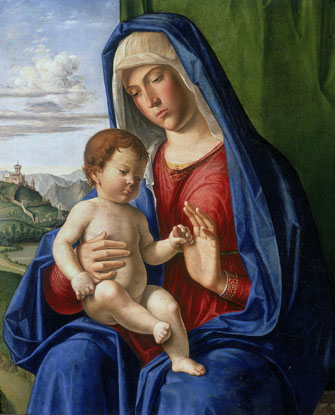A Venetian Master
Rediscovered in All His Glory

”Madonna with Child,” by Cima da Conegliano. © Archives Alinari, Florence, Dist. Service Presse RMN–Grand Palais/Daniela Camilli
In the late 15th century, Giovanni Battista Cima (1459-1517) came out of nowhere to make a name for himself as a painter in Venice, and he seems to have come out of nowhere once again in the 21st century to make a name for himself in Paris, where his work has rarely been shown. The exhibition “Cima da Conegliano: Maître de la Renaissance Vénitienne” at the Musée du Luxembourg will be a great discovery for anyone who is not familiar with his work.
The son of a textile manufacturer in the small town of Conegliano in the Venetia, Cima did not grow up surrounded by other artists in the studio system of the time. While he learned from his predecessors, among them Antonello da Messina (1430-1479) and Giovanni Bellini (c. 1430–1516), his innovations—among them the use of intense, pure color and the setting of sacred scenes in realistic decors—are said to have influenced many of his contemporaries, among them Bellini, Giorgione and even Albrecht Dürer, as well as the stars of later generations, including Lorenzo Lotto (1480-1556) and Titian (1490-1576).
A look at the 30 paintings in the show, many of which have not been exhibited outside Italy before, immediately makes it clear why he was so influential. While formally elegant, serene and beautiful, they are not merely decorative. Close examination shows that Cima was also a master at depicting emotion (see “The Incredulity of Saint Thomas and Saint Magnus, Bishop” for a good example).
In one of the first of several lovely paintings of the Madonna and Child, dating from 1490-93 (pictured above), the search for three-dimensional effects—a theme of Venetian painting of the day—can be seen in the roundness of the Madonna’s ruddy cheeks and in the little pot belly of the Christ Child. Notice the sumptuous contrasting colors of Mary’s red dress and blue veil against the green backdrop (a color scheme that is repeated in many of these paintings) and the exquisite details of the tiny buttons at the neckline and the delicate pattern on the neck and sleeve of her dress.
The Madonna and Child next to it, dating from 1500-02, is nearly identical, but there is more movement in the child’s pose, and a chapel has been added to a hilltop—Cima also excelled in painting architectural settings and landscapes, as well as draperies.
In the same room, “Madonna and Child Enthroned between Saint James and Saint Jerome” places the Virgin and Child on a marble throne under a trellis of vine leaves flanked by the two saints. All looks perfect and harmonious, until you move in for a close look and see a lizard crawling up the throne, a symbol of the Resurrection, and the tufts of grass sprouting through cracks in the reddish marble, representing the blood of the Passion.
If you love Italian painting, under no circumstances miss this uplifting show. And make sure you pick up the English translation of the excellent commentaries on several of the paintings when you present your ticket.
Musée du Luxembourg: 19, rue de Vaugirard, 75006 Paris. Métro: Saint-Sulpice or Odéon. RER: Luxembourg. Tel.: 01 40 13 62 00. Open Friday-Monday, 9am-10pm; Tuesday-Thursday, 10am-8pm (during school holiday, daily 9am-10pm). Closed Christmas Day. Admission: €12. Through July 15, 2012. www.museeduluxembourg.fr
Reader Reaction: Click here to respond to this article (your response may be published on this page and is subject to editing).
Please support Paris Update by ordering books from Paris Update’s Amazon store at no extra cost. Click on your preferred Amazon location: U.K., France, U.S.
More reviews of Paris art shows.
© 2012 Paris Update
